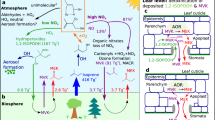Abstract
Isoprene (2-methyl-1,3,-butadiene), produced by many woody and a few herbaceous plant species, is the dominant volatile organic compound released from vegetation. It represents a non-trivial carbon loss to the plant (typically 0.5–2%, but much higher as temperatures exceed 30°C), and plays a major role in tropospheric chemistry of forested regions, contributing to ozone formation. This review summarizes current knowledge concerning the occurrence of isoprene production within the plant kingdom, and discusses other aspects of isoprene biology which may be of interest to the ecological community. The ability to produce significant amounts of isoprene may or may not be shared by members of the same plant family or genus, but emitting species have been found among bryophytes, ferns, conifers and Ephedra and in approximately one-third of the 122 angiosperm families examined. No phylogenetic pattern is obvious among the angiosperms, with the trait widely scattered and present (and absent) in both primitive and derived taxa, although confined largely to woody species. Isoprene is not stored within the leaf, and plays no known ecological role as, for example, an anti-herbivore or allelopathic agent. The primary short-term controls over isoprene production are light and temperature. Growth in high light stimulates isoprene production, and growth in cool conditions apparently inhibits isoprene, production of which may be induced upon transfer to warmer temperatures. The stimulation of isoprene production by high irradiance and warm temperatures suggests a possible role in ameliorating stresses associated with warm, high-light environments, a role consistent with physiological evidence indicating a role in thermal protection.
Similar content being viewed by others
Author information
Authors and Affiliations
Additional information
Received: 1 April 1998 / Accepted: 9 November 1998
Rights and permissions
About this article
Cite this article
Harley, P., Monson, R. & Lerdau, M. Ecological and evolutionary aspects of isoprene emission from plants. Oecologia 118, 109–123 (1999). https://doi.org/10.1007/s004420050709
Issue Date:
DOI: https://doi.org/10.1007/s004420050709




